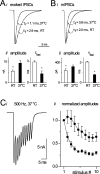Inhibitory control at a synaptic relay
- PMID: 15028756
- PMCID: PMC6729505
- DOI: 10.1523/JNEUROSCI.5144-03.2004
Inhibitory control at a synaptic relay
Abstract
The mammalian medial nucleus of the trapezoid body (MNTB) harbors one of the most powerful terminals in the CNS, the calyx of Held. The mechanisms known to regulate this synaptic relay are relatively ineffective. Here, we report the presence of a remarkably robust and fast-acting glycinergic inhibitory system capable of suppressing calyceal transmission. Evoked glycinergic IPSCs were relatively small in 2-week-old rats, an age by which calyceal maturation has reportedly neared completion. However, by postnatal day 25 (P25), glycinergic transmission had undergone a vigorous transformation, resulting in peak synaptic conductances as high as 280 nS. These are comparable with glutamatergic conductances activated by calyceal inputs. Decay kinetics for IPSCs were severalfold faster than for glycinergic synaptic events reported previously. At physiological temperatures in P25 rats, IPSCs decayed in approximately 1 msec and could be elicited at frequencies up to 500 Hz. Moreover, EPSPs triggered by glutamatergic signals derived from the calyx or simulated by conductance clamp were suppressed when preceded by simulated glycinergic IPSPs. The matching of excitatory transmission in the calyx of Held by a powerful, precision inhibitory system suggests that the relay function of the MNTB may be rapidly modified during sound localization.
Figures



References
-
- Ali DW, Drapeau P, Legendre P (2000) Development of spontaneous glycinergic currents in the Mauthner neuron of the zebrafish embryo. J Neurophysiol 84: 1726–1736. - PubMed
-
- Awatramani GB, Lu T, Turecek R, Trussell LO (2003) Development of GABA- and glycinergic transmission in the MNTB. Soc Neurosci Abstr 29: 387.12.
-
- Batra R, Fitzpatrick DC (1997) Neurons sensitive to interaural temporal disparities in the medial part of the ventral nucleus of the lateral lemniscus. J Neurophysiol 78: 511–515. - PubMed
-
- Blatchley BJ, Cooper WA, Coleman JR (1987) Development of auditory brainstem response to tone pip stimuli in the rat. Brain Res 429: 75–84. - PubMed
Publication types
MeSH terms
Substances
Grants and funding
LinkOut - more resources
Full Text Sources
Miscellaneous
